
The bombing occurred on April 19, 1995. I was in the 10th grade, and remember being in class when we found out about the bombing. A teacher rushed into the classroom, whispered the news to our teacher, who immediately went to turn on the television. We watched the news for the rest of that class.
The Memorial has 168 glass, stone and bronze chairs, each representing a person that died in the blast. According to wikipedia, the chairs "represent the empty chairs at the dinner tables of the victim's family. The chairs are arranged in nine rows symbolizing the nine floors of the building, and each person's chair is on the row (or the floor) on which the person worked or was visiting when the bomb went off. The chairs are also grouped according to the blast pattern, with the most chairs nearest the most heavily damaged portion of the building. The westernmost column of five chairs represents the five people who died but were not in the Murrah Building when the bomb went off (two in the Water Resources Board building, one in the Athenian Building, one outside near the building, and one rescuer). The 19 smaller chairs represent the children killed in the bombing. Three unborn children died along with their mothers, and they are listed on their mothers' chairs beneath their mothers' names."
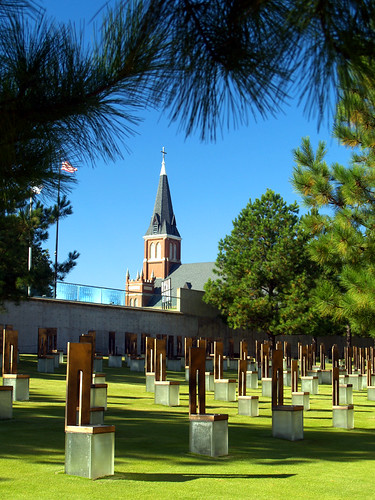
The reflecting pool runs through the middle of the monument, along the street where the truck bomb was parked. At each end of the reflecting pool is a Gate of Time, one showing 9:01 and the other 9:03.
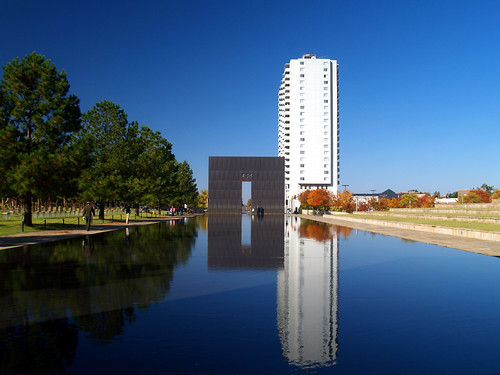
On the north side of the Memorial is the Survivor's Tree. Before the bombing the area where the tree sits was a parking lot, with the tree providing the only source of shade. The tree is thought to be over a hundred years old, and it appears in photos taken way back in 1907.
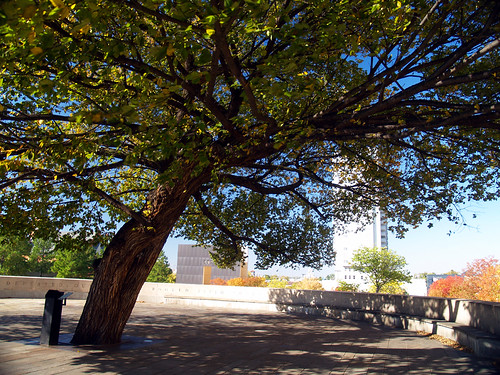
The tree was heavily damaged during the blast, which took out most of the its branches. Fires from cars parked beneath the tree burned the trunk, and the bark had glass and other debris embedded in it. Again, from wikipedia: "Most thought the tree could not survive. However, almost a year after the bombing, family members, survivors and rescue workers gathered for a memorial ceremony under the tree noticed it was beginning to bloom again. The Survivor Tree now thrives, in no small part because the specifications for the Outdoor Memorial design included a mandate to feature and protect the Tree. One example of the dramatic measures taken to save the Tree: one of the roots that would have been cut by the wall surrounding the Tree was placed inside a large pipe, so it could reach the soil beyond the wall without being damaged. A second example is the decking around the Tree, which is raised several feet to make an underground crawlspace; workers enter through a secure hatchway and monitor the health of the Tree and maintain its very deep roots." The Survivor Tree has become an emblem for the Memorial.
This graffiti was painted onto the Journal Record Building, which stands next to the Survivor Tree and that is now home to the Oklahoma City National Memorial Museum.
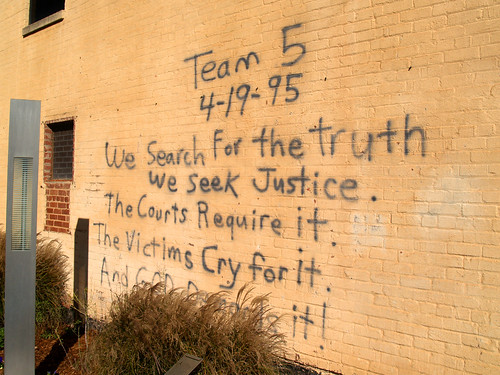
Plants obscure it a bit, but the last line says "And GOD Demands it!"
In the planning stages of the bombing, Timothy McVeigh and Terry Nichols considered several other federal buildings in other states. One of those buildings they visited and scouted was the federal building in Little Rock. They were looking for a federal building that housed the FBI, the ATF and DEA. Those agencies weren't all located in the Little Rock federal building, some were located in what was then called the TCBY Tower. McVeigh and Nicols visited the TCBY Tower, and decided to not bomb the tallest building in Arkansas. The reason? "Wanting to minimize nongovernmental casualties, he ruled out the building in Little Rock because of the presence of a florist's shop on the ground floor." So instead he chose the Oklahoma City federal building, which had a daycare on the first floor.
This photo was taken in what used to be a plaza between the Oklahoma City Federal Building and the Federal Court House across the street.
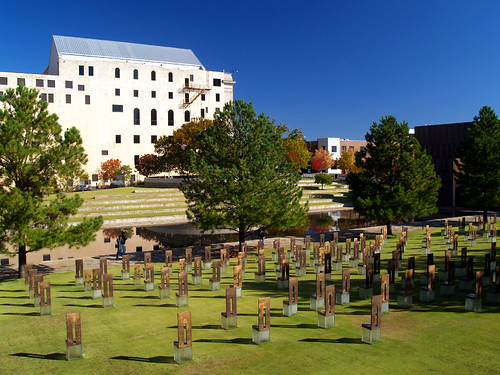
About 20 feet away from the spot this picture was taken was a fenced off grassy area. A small sign said that this spot was used by the daycare as a playground area.
Across the street from the Memorial is St. Joseph's Catholic Church. The church was one of the first churches in Oklahoma City, and it was heavily damaged during the bombing. The church's rectory building was destroyed, and on the spot where it stood is this memorial built by the church. It has a statue of a weeping Jesus, with His back turned to the site of the destruction. Around the statue is a stone wall, with a niche for each victim of the bombing.
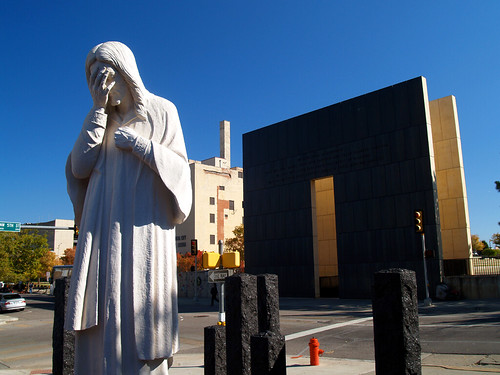
The Oklahoma City National Memorial is a thoughtful and poignant place. It is a horrible shame that such evil exists that it needed to have ever been made.


4 comments:
very sad and I remember this well. It was on one of my best friends birthdays. The daycare part really hurts me. I couldn't imagine losing my son.
Such a sad moment in our history. I remember that day pretty well too. I was home sick from school and was a news junkie child. (Weird, I know.) I had the news on when the story broke. I watched it all day hoping they'd find the kids all alive. :-(
Brings back memories... I worked for ABC News and logged more than 1000 liveshots on paper for various stations across the globe for 15 days. I arrived while it was still smoking and will never forget the feelings and images from seeing all the bloody people walking around. Glad we have the memorial!
Yeah, who can ever forget that one photo of the firefighter carrying out the baby in his arms?
Visiting there reminded me of the time I went to Ground Zero in New York City. It was a few years back, and the site looked like a huge construction site, but it had the same sense of sadness and tragedy hanging over it.
Post a Comment